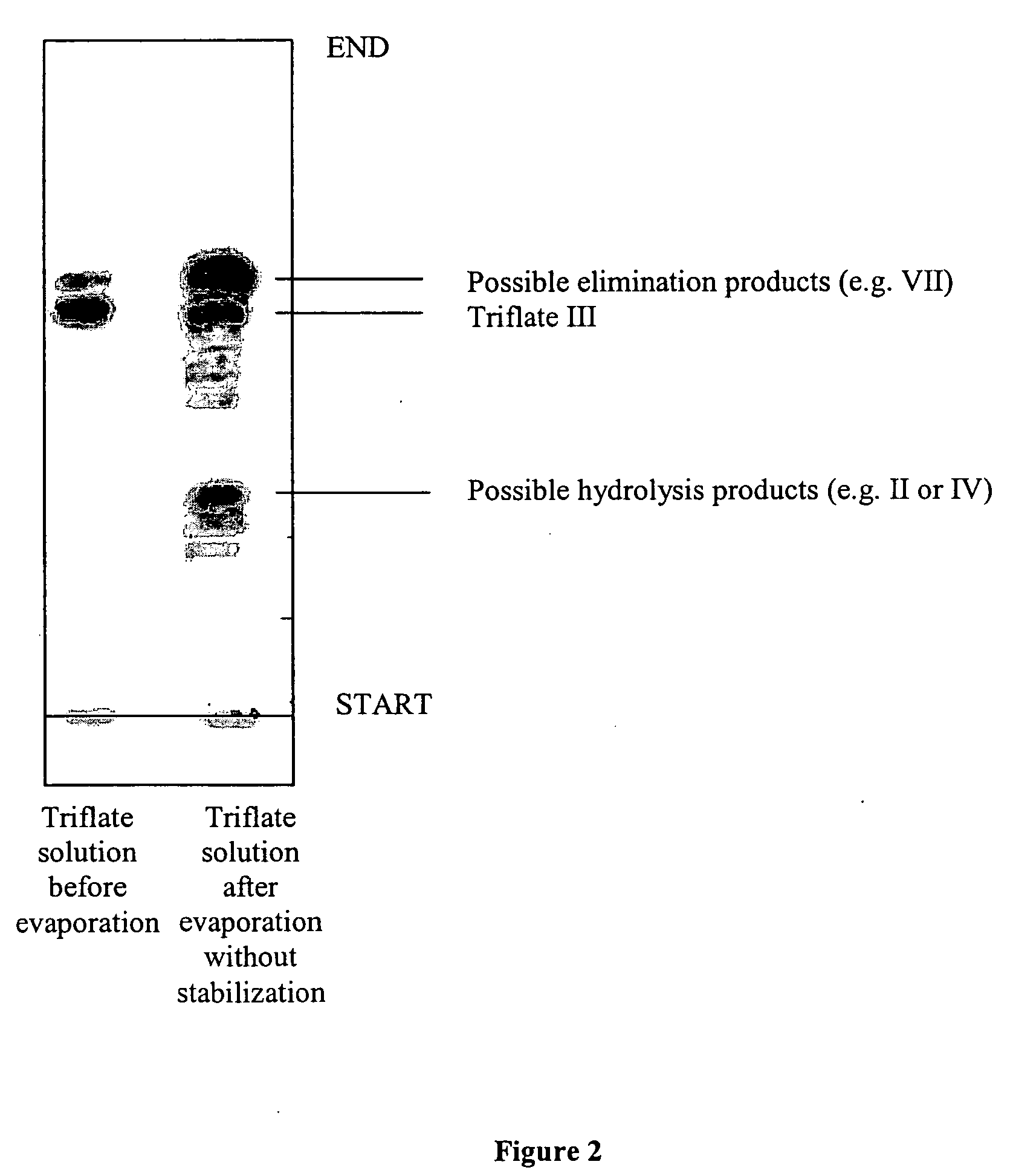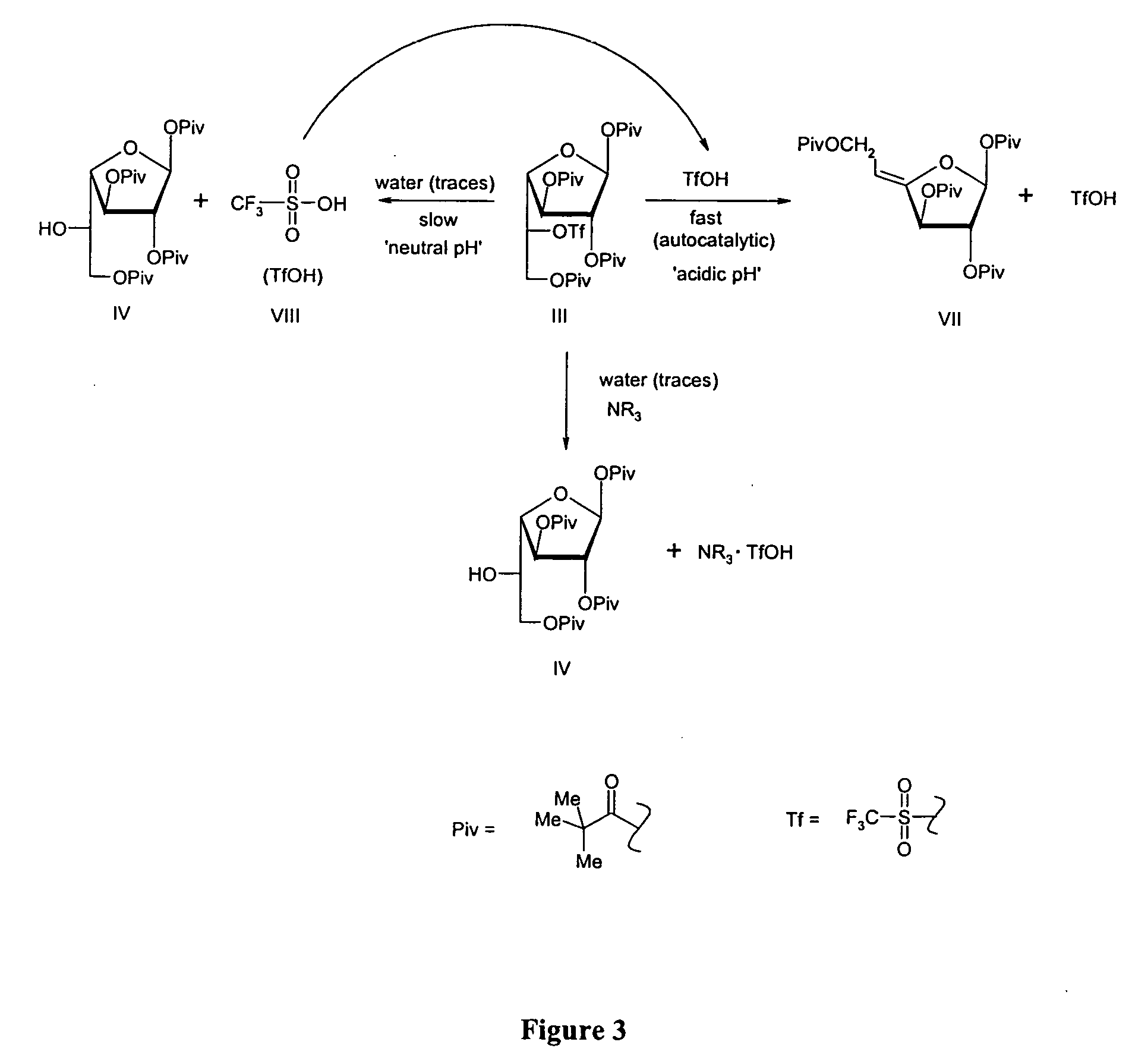Stabilization of triflated compounds
a triflated compound and stabilizer technology, applied in the field of stabilized triflated compounds, can solve the problems of reducing reaction yield, difficult industrial scale production of multi-kilogram quantities, and sensitive to moisture of triflated compounds
- Summary
- Abstract
- Description
- Claims
- Application Information
AI Technical Summary
Benefits of technology
Problems solved by technology
Method used
Image
Examples
example 1
Preparation and Stabilization of 3-trifluoromethoxy-3-deoxy-1,2,1,8-tetrapivaloyl-α-D-galactofuranoside
[0062] 5 kg of 1,2,3,6-tetrapivaloyl-α-D-galactofuranoside was combined with 1.2 equivalents (3.3 kg) of trifluoromethanesulfonic anhydride and 5 equivalents (3.8 kg) of pyridine in 25 L of methylene chloride at 0° C. About 2 hours, the reaction mixture was with cold hydrochloric acid solution and subsequently with sodium bicarbonate solution until pH of the mixture was neutral. To methylene chloride solution of triflate was added 0.2 equivalents (230 mL) Hunig's base, and the solution was evaporated to get the titled compound. The decomposition of this compound can be seen in FIG. 2 if no base is added before evaporation.
example 2
Stabilization of Tetrapivaloyl Furanose
[0063] Following the process described in Example 1, 5 kg of a pivaloylated galactofuranoside was combined with 1.2 equivalents (3.3 kg) of trifluoromethanesulfonic anhydride and 5 equivalents (3.8 kg) of pyridine in 25 L of methylene chloride at 0° C. After about 2 hours, the reaction mixture was washed with cold hydrochloric acid solution and subsequently with sodium bicarbonate solution until pH of the mixture became neutral. To the methylene chloride solution of triflate was added 0.2 equivalents (230 mL) Hunig's base, and the solution was evaporated to get the titled compound.
example 3
Preparation and Stabilization of 3-trifluoromethoxy-3-deoxy-1,2,1,8-tetrapivaloyl-α-D-galactofuranoside
[0064] 5 kg of 1,2,3,6-tetrapivaloyl-α-D-galactofuranoside 1 is combined with 1.2 equivalents (3.3 kg) of trifluoromethanesulfonic anhydride and 5 equivalents (3.8 kg) of pyridine in 25 L of methylene chloride at 0° C. After 2 hours, the reaction mixture is washed with cold hydrochloric acid solution and subsequently with sodium bicarbonate solution until pH of the mixture becomes neutral. To methylene chloride solution of triflate is added 0.2 equivalents of triethylamine, and the solution was evaporated to get the titled compound.
PUM
| Property | Measurement | Unit |
|---|---|---|
| stable | aaaaa | aaaaa |
| temperature | aaaaa | aaaaa |
| stability | aaaaa | aaaaa |
Abstract
Description
Claims
Application Information
 Login to View More
Login to View More - R&D
- Intellectual Property
- Life Sciences
- Materials
- Tech Scout
- Unparalleled Data Quality
- Higher Quality Content
- 60% Fewer Hallucinations
Browse by: Latest US Patents, China's latest patents, Technical Efficacy Thesaurus, Application Domain, Technology Topic, Popular Technical Reports.
© 2025 PatSnap. All rights reserved.Legal|Privacy policy|Modern Slavery Act Transparency Statement|Sitemap|About US| Contact US: help@patsnap.com



